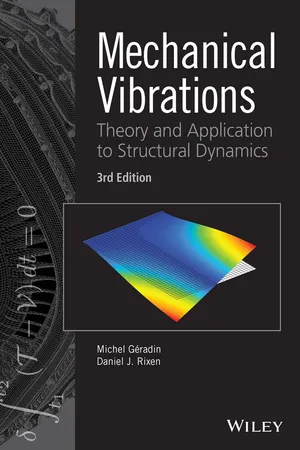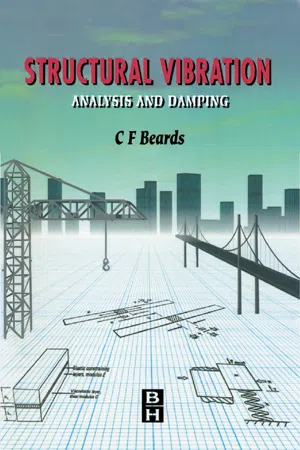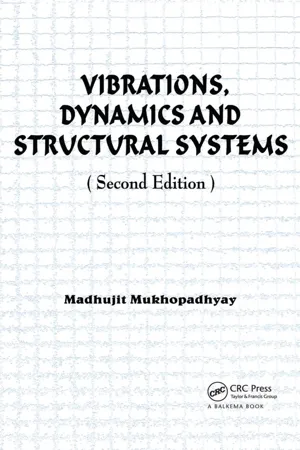Technology & Engineering
Damped Free Vibration
Damped free vibration refers to the oscillatory motion of a system that gradually decreases in amplitude over time due to the dissipation of energy. This damping effect can be caused by factors such as friction, air resistance, or material properties. In engineering, understanding damped free vibration is crucial for designing structures and machines that can effectively manage and minimize the effects of vibration.
Written by Perlego with AI-assistance
Related key terms
Related key terms
1 of 4
Related key terms
1 of 3
8 Key excerpts on "Damped Free Vibration"
- eBook - ePub
Engineering Dynamics
Fundamentals and Applications
- M Rashad Islam, A K M Monayem H Mazumder, Mahbub Ahmed(Authors)
- 2022(Publication Date)
- CRC Press(Publisher)
7 Vibration DOI: 10.1201/9781003283959-7 7.1 General Mechanical vibration, or simply vibration, is the measurement of periodic oscillations with respect to an equilibrium condition of an object. Sometimes, vibrations are desirable in certain types of machine tools or production lines. However, most of the time, vibration of mechanical systems is not desirable due to wasting energy, reducing efficiency, and safety considerations. For example, passenger ride comfort in aircraft or automobiles is greatly affected by the vibrations caused by outside disturbances, such as aero-elastic effects or rough road conditions. In other cases, eliminating vibrations may save human lives; a good example of this is the vibration of civil engineering structures during an earthquake. Vibrations can be classified as: (a) Free and Forced Vibration. Free vibration means the system is left to vibrate on its own after the initial disturbance. In forced vibration, the system is subjected to an external repeating type of force, and the system vibrates in response to that. (b) Damped and Undamped. If no energy is lost or dissipated by friction or other resistance during oscillation, the vibration is known as undamped vibration. If any energy is lost in this way, it is called damped vibration. In many physical systems, the amount of damping is so small that it can be disregarded for most engineering purposes. (c) Linear and Nonlinear. If all the basic components of a vibration system such as spring, mass, and the damper behave linearly, then it is called linear vibration. In nonlinear vibration, one or more basic components of a vibration system do not behave in a linear manner. (d) Deterministic or Not. Deterministic means the magnitude of the excitation (force or motion) acting on a vibratory system is known at any given time. In random vibration, the value of the excitation at any given time cannot be predicted - eBook - ePub
Mechanical Vibrations
Theory and Application to Structural Dynamics
- Michel Geradin, Daniel J. Rixen(Authors)
- 2014(Publication Date)
- Wiley(Publisher)
Chapter 3 Damped Vibrations of n-Degree-of-Freedom Systems Damping forces have already been introduced briefly in Chapter 1 to underline their non-conservative character.Damping is one of the most important aspects to model and predict in structural analysis, as it determines for a major part the performance of a structural system or the amplitude of its vibrations. It is probably also one of the most uncertain and difficult ones to address in vibration analysis and structural dynamics, due to the variety and complexity of its physical origin. Indeed damping can arise from many different sources, such as (Mead 1998):- intrinsic damping of the structural material;
- Coulomb friction and partial-impact energy loss at structural interfaces;
- energy lost into surrounding air, water or ground and into contained fluids;
- friction between the structure and mounted equipment, furnishings, payload and people;
- viscous damping between sliding and lubricated machines surfaces.
In all generality, the damping forces can be expressed as functions of the structural velocities , the strain rates in the material and the system configuration . The strains being themselves expressed as spatial derivatives of (see Chapter 4, Section 4.1), we may write in all generality:3.1and this function can be dependent on the history of the behaviour of the system. Inthis chapter, we will make the approximation that the damping is linear in the velocities (viscous damping) and independent of unless otherwise stated. It can thus be described by a dissipation function quadratic in velocities as introduced in Chapter 1, Section 1.3.3.Structural damping in itself is a huge subject which could not be covered in a single book chapter. The presentation will focus on the following aspects.In Section 3.1 the linear damping model will be described and its essential mathematical properties will be outlined. The classical assumption of modal damping which consists of neglecting the coupling of eigenmodes through damping will be introduced and its validity range discussed. A general method based on modal expansion to construct a proportional damping matrix matching experimentally measured modal damping ratios will be presented. - eBook - ePub
- Bikash C. Chakraborty, Debdatta Ratna(Authors)
- 2020(Publication Date)
- Elsevier(Publisher)
Fig. 1.8 depicts the nature of the decay, which is an exponential curve having no sinusoidal component.Fig. 1.8 Free vibration of an SDOF system, undamped and critically damped.1.5.2.3 Case (3)—Overdamped system
The vibration response is overdamped when the damping factor is > 1, that is, λ /λ C or ξ > 1. The solution to Eq. (1.12) can beut=C 1exp+− ξ +1 −ξ 2ω ntC 2− ξ −1 −ξ 2ω nt(1.21)where C 1 and C 2 are the coefficients of integration and can be found out by solving the equation using initial conditions u 0 and v 0 . The solution becomesu t =expu 0ω nξ ++ξ 2− 1v 02ω nξ 2− 1+− ξ +ξ 2− 1ω ntexp−u 0ω nξ −−ξ 2− 1v 02ω nξ 2− 1− ξ −ξ 2− 1ω nt(1.22)This is also a uniform exponential decay curve without any vibration characteristics. A typical response curve is given in Fig. 1.9 . Example of an underdamped system is common, including cured rubber bushes and mounts, while a typical example of an overdamped system is the unvulcanised butyl rubber latex.Fig. 1.9 Overdamped SDOF system in free vibration, compared with undamped and critically damped systems.1.5.3 Forced vibration
When an external oscillatory excitation force is applied onto a body, the resulting vibration is termed as forced vibration. In the event of a frequency sweep by an external exciter, when the sweeping frequency coincides with that of the natural frequency of the system, the phenomenon is called resonance and at that point, the amplitude of vibration would be maximum. In a random vibration, such as a running turbine, there can be many subsequent higher modes.1.5.3.1 Frequency response in undamped forced vibration
Let F 0 sin(ωt - eBook - ePub
- Juan Carlos A. Jauregui Correa, Alejandro A. Lozano Guzman(Authors)
- 2020(Publication Date)
- Academic Press(Publisher)
c can also be obtained. However, it's important to remark that the value of the damping coefficient of a system only depends on the damper while with the damping factor, it is determined by the parameters of the mechanical system.Forced vibration
Every machine is subjected to external excitations, which are related to the operating conditions and the mechanical configuration of each component. For conditioning monitoring systems, this characteristic boosts the prediction of failures at a component level. Thus, it is important to deeply understand the response of a mechanical system to a forced excitation. The simplest system is a one-degree-of-freedom mass-spring system (a simple linear pendulum of a single-degree-of-freedom oscillator has the same dynamic response). The most illustrative case is when the excitation force is represented as a simple harmonic excitation. The response of a one-degree-of-freedom system to a harmonic excitation is presented next. An essential part of the study of mechanical vibrations is the knowledge of the response of the system to an external excitation. In the case of the machinery, the main source of this external excitation comes from the power supply to the machine through the motors used for its operation. This means that, once the machine starts up, forced vibrations will occur. However, the total elimination of these vibrations is impossible because the very operation of the engines in industrial conditions is subject to the variation of their components, tolerances, mismatches, imbalances, variations in the power supply, and wear of parts; in other words, countless causes. The purpose, therefore, is to keep these vibrations at tolerable levels. With vibration monitoring for predictive maintenance, the intention is to identify the source of any change in the tolerable levels of forced vibration before they exceed the reference levels of normal operation. - eBook - ePub
Structural Vibration
Analysis and Damping
- C. Beards(Author)
- 1996(Publication Date)
- Butterworth-Heinemann(Publisher)
b the building will fall over when disturbed.2.2 FREE DAMPED VIBRATION
All real structures dissipate energy when they vibrate. The energy dissipated is often very small, so that an undamped analysis is sometimes realistic; but when the damping is significant its effect must be included in the analysis, particularly when the amplitude of vibration is required. Energy is dissipated by frictional effects, for example that occurring at the connection between elements, internal friction in deformed members, and windage. It is often difficult to model damping exactly because many mechanisms may be operating in a structure. However, each type of damping can be analysed, and since in many dynamic systems one form of damping predominates, a reasonably accurate analysis is usually possible.The most common types of damping are viscous, dry friction and hysteretic. Hysteretic damping arises in structural elements due to hysteresis losses in the material. The type and amount of damping in a structure has a large effect on the dynamic response levels.2.2.1 Vibration with viscous damping
Viscous damping is a common form of damping which is found in many engineering systems such as instruments and shock absorbers. The viscous damping force is proportional to the first power of the velocity across the damper, and it always opposes the motion, so that the damping force is a linear continuous function of the velocity. Because the analysis of viscous damping leads to the simplest mathematical treatment, analysts sometimes approximate more complex types of damping to the viscous type.Consider the single degree of freedom model with viscous damping shown in Fig. 2.12 .Fig. 2.12 Single degree of freedom model with viscous damping.The only unfamiliar element in the system is the viscous damper with coefficient c . This coefficient is such that the damping force required to move the body with a velocity - C. Beards(Author)
- 1995(Publication Date)
- Butterworth-Heinemann(Publisher)
M , assuming the soil acts similarly in tension and compression isThus the equation of motion becomes Motion is therefore simple harmonic, with frequency An alternative solution can be obtained by considering the energy in the system. In this case, andwhere the loss in potential energy of building weight is given by since for small values of θ. ThusAssuming simple harmonic motion, and putting T max = V max , givesas before. Note that for stable oscillation, ω > 0, so thatThat is ka 3 b > 12 mgh .This expression gives the minimum value of k , the soil stiffness, for stable oscillation of a particular building to occur. If k is less that 12 mgh/a 3 b the building will fall over when disturbed.2.2 FREE DAMPED VIBRATION
All real systems dissipate energy when they vibrate. The energy dissipated is often very small, so that an undamped analysis is sometimes realistic; but when the damping is significant its effect must be included in the analysis, particularly when the amplitude of vibration is required. Energy is dissipated by frictional effects, for example that occurring at the connection between elements, internal friction in deformed members, and windage. It is often difficult to model damping exactly because many mechanisms may be operating in a system. However, each type of damping can be analysed, and since in many dynamic systems one form of damping predominates, a reasonably accurate analysis is usually possible.The most common types of damping are viscous, dry friction and hysteretic. Hysteretic damping arises in structural elements due to hysteresis losses in the material. The type and amount of damping in a system has a large effect on the dynamic response levels.2.2.1 Vibration with viscous damping
Viscous damping- Madhujit Mukhopadhyay(Author)
- 2023(Publication Date)
- CRC Press(Publisher)
Fig. 2.3(b) . Again in the machine, the forces that act are the inertia force, the spring force, the damping force and the external force.From the above examples it is seen, that for studying the vibration of any system, the following are the four elements of importance:Fig. 2.3. A spring mounted machine and its freebody- (a) The inertia force,
- (b) The damping force,
- (c) The restoring force, and,
- (d) The exciting force.
If the external force is zero, the resulting vibration is called the free vibration. In such cases, if damping is present in the system, it is called free damped vibration and if damping is absent in the system, it is called free undamped vibration.The two systems mentioned above, can be idealised in the form of spring-mass system as shown in Fig. 2.4 . All structures can be reduced to systems consisting of combinations of springs, masses and dashpots and is an idealisation in a convenient form of the actual structure.Fig. 2.4. A spring-mass- dashpot systemThe only independent coordinate of the spring-mass system of Fig. 2.4 is the x-directional translation and the displacement will simply be given by x, velocityApplying D’Alembert’s principle and considering equilibrium of all the forces in the x-direction, the general equation of motion for the SDF system isand accelerationx ˙(=)d xd t. The inertia force of the mass is mẍ, the damping force is cẋ and the spring force is kx. The external force acting on the system is F(t).x ¨(=)d 2xdt 2
The solution of Eq. (2. 1) gives the response of the mass to the applied force in the SDF system.mx ¨+ cx ˙+ k x = F ( t )(2.1) 2.3 Free Undamped Vibration of the SDF System
When the case of free undamped vibration is considered, F (t) = 0 and c- eBook - ePub
- Jens Holger Rindel(Author)
- 2017(Publication Date)
- CRC Press(Publisher)
Chapter 2Mechanical vibrations2.1 A SIMPLE MECHANICAL SYSTEM
In this chapter, we shall look at one-dimensional vibrations in a simple mechanical system consisting of a mass, a spring and a damping element. Since the vibrations can be fully described in one dimension, this is also called a system with one degree of freedom.First, the use of complex notation is shown for harmonic vibrations as a basis for later applications in acoustic vibrations and sound fields. Next, the vibrations in a resonant mechanical system are dealt with, as a basis for numerous applications in resonant acoustic systems. Finally, the theory for vibration isolation is explained as this has fundamental importance for noise control of machines and equipment in practice. The description follows the terminology and concepts in ISO 2041.Figure 2.1 shows a mechanical system consisting of a mass m placed on an elastic layer on top of a rigid, unmovable surface. The elastic layer has the stiffness k symbolized as a spring and the resistance r symbolized as a dashpot. Some materials have slightly different stiffness for static load and for a dynamic excitation, and thus, we will distinguish between those cases. The acceleration due to gravity means that the system has a static excitation, which leads to a compression of the elastic layer. The static displacement is by definition:x s=m gk s ( 2.1 )where g = 9.81 ms−2 is the acceleration due to gravity and k s is the static stiffness (N/m).In the case of a dynamic excitation of the system by the force F , we have the equation of motion from Newton’s second law:m+ rd 2xdt 2+d xd tk dx = F ( 2.2 )Figure 2.1 (a) Simple mechanical system. (b) Static deflection due to mass load and gravity. (c) Dynamic excitation by an external force.where x is the displacement from the rest position, t is the time and k d is the dynamic stiffness (N/m).As long as the external force is active, the system is said to display forced vibrations. However, when the force stops, the system can still exhibit vibrations for a shorter or longer time after the force is stopped. These are resonant or free vibrations.
Index pages curate the most relevant extracts from our library of academic textbooks. They’ve been created using an in-house natural language model (NLM), each adding context and meaning to key research topics.
Explore more topic indexes
Explore more topic indexes
1 of 6
Explore more topic indexes
1 of 4







